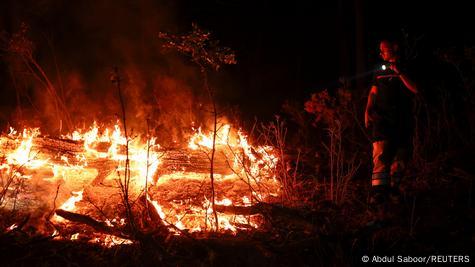Giant Fire in Southern France Under Control
In a significant development, firefighters in southern France have successfully brought a massive wildfire under control after several days of intense battling against the flames. The fire, which erupted in the picturesque Var region, prompted emergency evacuations and raised concerns about environmental impacts and local safety. While the threat to surrounding communities has diminished, officials remain vigilant as the region continues to grapple with the aftermath of this devastating blaze. As authorities assess the damage and investigate the cause, the resilience of both firefighters and local residents shines through in the face of adversity.
Giant Fire in Southern France: Current Status and Response Efforts
The giant fire that has ravaged parts of southern France is now reported to be under control, thanks to the tireless efforts of local firefighters and emergency services. Over 1,500 firefighters, aided by aircraft and ground units, converged on the affected areas, combating the flames that threatened homes and wildlife. The fire, which has burned through an estimated 2,500 hectares of land, prompted extensive evacuation measures in nearby communities, ensuring the safety of residents. Reports indicate no serious injuries, but the impact on local ecosystems remains a significant concern.
The coordinated response involved multiple agencies and volunteers, showcasing a model of collaborative disaster management. Key actions taken include:
- Evacuations: Residents from several villages were safely relocated.
- Firebreaks: Strategic barriers were established to prevent the fire’s spread.
- Aerial Support: Water-dumping aircraft played a critical role in suppressing the flames.
In addition to immediate firefighting efforts, authorities are preparing for a comprehensive assessment of the damage and recovery options. A task force will be set up to evaluate the ecological effects and initiate restoration projects. The community remains on alert as predictions of dry winds could affect stability in the region.
Impact on Local Communities and Wildlife: An In-Depth Assessment
The recent giant fire in southern France has left a significant mark on both local communities and wildlife, bringing to the forefront the complexities of ecological and social stability. As firefighters work tirelessly to contain the inferno, the smoke billowing across the region poses immediate health risks to residents, particularly those with pre-existing respiratory conditions. Local authorities have initiated precautionary measures, including evacuations and temporary shelters, to safeguard affected populations while coordinating efforts to stabilize the situation. The economic implications are also profound; many small businesses reliant on tourism have seen a downturn, and the agricultural sector faces potential crop losses that could ripple through the local economy for years to come.
Equally concerning is the fire’s impact on local wildlife and ecosystems. The fire ravaged hundreds of acres of forest, a critical habitat for various species, including endangered birds and other native fauna. In response to this ecological crisis, conservation groups are mobilizing to assess and monitor the damage. Key initiatives to help wildlife recovery include:
- Habitat Restoration: Efforts to replant native species and restore soil health.
- Wildlife Rehabilitation: Establishing care facilities for injured animals.
- Community Engagement: Involving local residents in monitoring and conservation activities.
| Impact Category | Description |
|---|---|
| Health Risks | Increased respiratory problems among residents. |
| Economic Loss | Decline in tourism and potential crop damage. |
| Wildlife Displacement | Loss of habitat for critical species. |
Lessons Learned: Enhancing Fire Management and Prevention Strategies
Recent large-scale wildfires, such as the one in southern France, underline the urgent need for improved fire management and prevention strategies. Lessons from this incident highlight the significance of integrating community engagement and advanced technology into firefighting efforts. Key strategies include:
- Community Training: Empowering local residents with fire safety skills can significantly reduce risks.
- Early Detection Systems: Utilizing drones and satellite imagery helps in monitoring and responding to fires before they escalate.
- Resource Allocation: Ensuring that firefighting resources are strategically located and optimized based on historical data.
Moreover, collaboration among various agencies proved vital. A unified command structure allows for a more streamlined response in crisis situations. An analysis of fire management success factors can be summarized in the table below:
| Strategy | Description |
|---|---|
| Community Involvement | Engaging locals in preparedness and response initiatives. |
| Data Utilization | Leveraging historical data for predictive modeling and risk assessment. |
| Inter-Agency Coordination | Facilitating efficient communication and resource sharing across various sectors. |
Future Outlook: Rebuilding and Resilience in Affected Areas
As the smoke clears and the immediate threat of the fire has receded, the focus shifts to the long-term recovery and rehabilitation of the affected regions in southern France. The devastation left in the wake of this disaster not only underscores the need for responsive firefighting strategies but also highlights the importance of rebuilding community resilience. Local authorities are gearing up for extensive evaluation processes, aiming to understand the full impact of the fire and to facilitate a holistic approach to recovery. Here are several key areas of focus:
- Infrastructure Renewal: Assessing and repairing damaged roads, bridges, and public facilities.
- Environmental Restoration: Implementing reforestation initiatives and safeguarding biodiversity.
- Community Engagement: Involving local residents in discussions to address their needs and concerns.
In conjunction with immediate recovery efforts, plans are being laid for sustainable practices to prevent future disasters. Policymakers are considering innovative land management techniques and investment in research for advanced firefighting technologies. Education programs are being proposed to raise awareness in communities about fire risks and preparedness strategies. A collaborative approach among governmental, non-profit, and private sectors will be crucial in ensuring the long-term resilience of these regions. The following table summarizes potential strategies for enhancing community preparedness:
| Strategy | Description |
|---|---|
| Firebreak Creation | Developing natural barriers to slow or stop fire spread. |
| Community Drills | Regular training for residents on evacuation and safety protocols. |
| Sustainable Land Use | Adopting agricultural practices that minimize fire risk. |
Future Outlook
In conclusion, the successful containment of the giant fire in southern France marks a significant achievement for local authorities and firefighting teams who have worked tirelessly to protect both lives and property. While the immediate danger has been mitigated, the aftermath of the blaze will require ongoing assessments and recovery efforts. As communities begin to rebuild, the focus will now shift to understanding the causes of such devastating wildfires and implementing measures to prevent future occurrences. The resilience of the affected regions remains a testament to the strength of their inhabitants, as they work together to heal and restore their environment.




